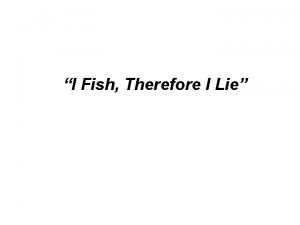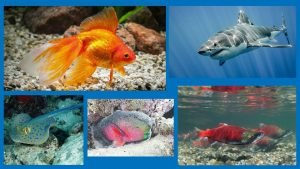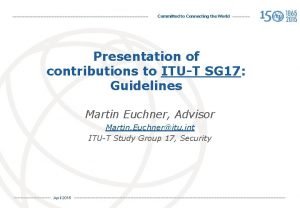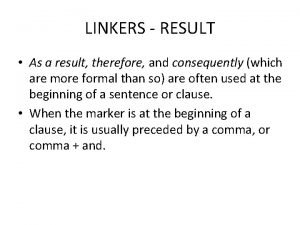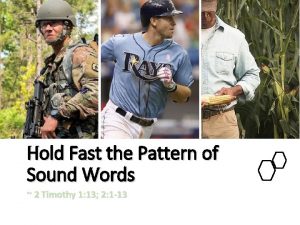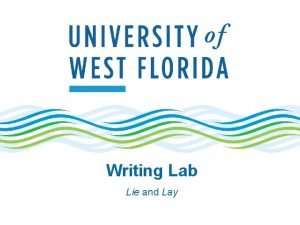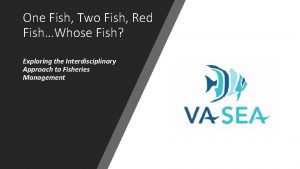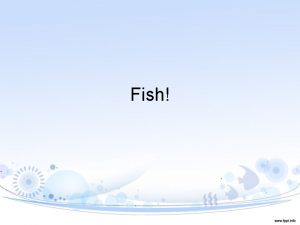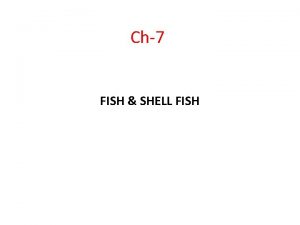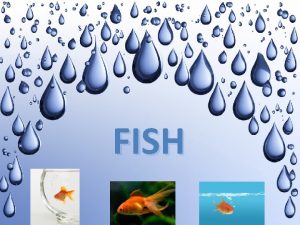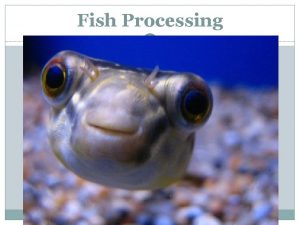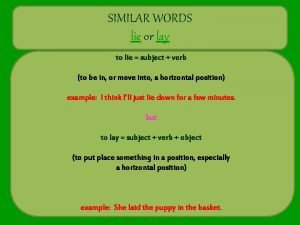I Fish Therefore I Lie OVERVIEW OF WORLD






























































- Slides: 62

“I Fish, Therefore I Lie”


OVERVIEW OF WORLD FISHERIES I. Reporting and Measurement Issues II. Major Fisheries - By Fish III. Major Fisheries - By Nation IV. Major Fisheries - By Ocean V. Possible Future Fisheries VI. Economic Values

I. Reporting and Measurement Issues “I Fish, Therefore I Lie” Food and Agriculture Organization, FAO Organizational Reporting Policies in General Chinese Reporting Policies in Particular

An Important Word: CREEL • Wicker Basket used to hold a fisher’s catch

An Important Word: CREEL • Wicker Basket used to hold a fisher’s catch • Fisheries Management term used to describe the mix of species in a fishing jurisdiction’s catch

Figure 3. 1. Capture Fishery Production from 1993 to 2002. (Note that the y-axis does not begin at zero)

Figure 3. 1. Capture Fishery Production from 1993 to 2002. (Note that the y-axis does not begin at zero)

II. Major Fisheries - by Fish THE FIRST TIER • Peruvian Anchovy • Alaskan Pollock • Skipjack Tuna • Capelin

Figure 3. 2. Historical Catches of: (A) Peruvian Anchovy; (B) Alaska Pollock; (C) Skipjack Tuna; and (D) Capelin. Note the different scales on the y axes!

Peruvian Anchovy • Not heavily fished until the 1950 s • By 1970, the largest fishery in the world • Susceptible to disruptions by ENSOs • Lessons may have been learned



Alaskan Pollock • Not heavily fished until the 1960 s • Improvements in processing ability were important • Overfishing a real concern • Monitoring and managing techniques may be improving


Skipjack Tuna • Another recently developed fishery • Catches are trending upwards • This resource may be underutilized • Monitoring and managing techniques are a challenge



Capelin • Yet another recently developed fishery • An early peak, a characteristic of some new fisheries • An equlibrium may be being attained • This fishery is dominated by two relatively cooperative countries


Capelin are members of the Osmeridae family of smelts. They are known as sparling in England. Capelin are slender translucent olive colored, small-scaled fish that grow to a maximum length of 25 cm (10 in). Capelin was once the primary food of cod in the North Atlantic. When the cod population diminished the capelin population increased dramatically. The species is found from the surface and down to depths of 300 metres. The bulk of the capelin catch goes for reduction into meal and oil, which is mostly used for production of animal feed, including salmon feed. But a part of the catch finds a market outlet in Japan where capelin is a popular snack and capelin roe is sought-after in Japan for its alleged aphrodisiac properties. During spawning, the male holds on tightly to the female with its pectoral and ventral fins and swims down towards the bottom. The majority die after spawning and only a few live to spawn a second time.

II. Major Fisheries - by Fish THE SECOND TIER • Atlantic Herring • Japanese Anchovy • Chilean Jack Mackerel • Blue Whiting

Figure 3. 3. Historical Catches of: (A) Atlantic Herring; (B) Japanese Anchovy; (C) Chilean Jack Mackerel; and (D) Blue Whiting.

Atlantic Herring • An old fishery - based on gill netting • Introduction of purse seine technology resulted in increased but unsustainable yields • Effective management may result in a stable fishery



Japanese Anchovy • A fishery with a long history of catch records • Stable until the entry of the Chinese into the fishery • Current high catch may not be sustainable


Japanese Anchovy • A fishery with a long history of catch records • Stable until the entry of the Chinese into the fishery • Current high catch may not be sustainable • “Alternatively, current high catch may not be real”

Chilean Jack Mackerel • This fishery began with the collapse of the Peruvian Anchovy • It was subject to initial overexploitation • The current yield may be sustainable; Stable at 2 million tonnes from 2002 through 2008


Blue Whiting • A relatively recent fishery • Unregulated until recently • Recent increases in catch are recognized as unsustainable


Blue Whiting • 2005. EU, Faeroes, Iceland, Norway, agree on a management plan • A limit of 2 million tonnes set for 2006 • Agreement on reduced limits, to 540, 000 tonnes by 2010

Blue Whiting • Until these multi-national agreements, Blue Whiting was exclusively used for reduction, to fish oil and animal feed. • With the new, lower, catch limits, attempts are being made to “add value” to this fishery.

Blue whiting (Micromesistius poutassou). Length to 30 -35 cm. Weight 150300 grams.

III. Major Fisheries - by Nation THE FIRST TIER • China • Peru • United States • Indonesia


China • From 1989 to 1998, 1 MT/yr increases were reported • From 1998 on, 0 MT/yr increases were reported • Virtual Biology


Peru • Catch dominated by a single species • Overfishing is a manageable threat • ENSO is not a manageable threat

United States • Stable since 200 mile EEZ established Indonesia • Inshore trawl catch isn’t well identified • Offshore tuna catch is 75% of fishery

III. Major Fisheries - by Nation THE SECOND TIER • Japan • Chile • India • Russia


Japan and Russia • Declines a consequence of the EEZ Chile • Decline a consequence of drops in catches of two heavily fished species India • 21% of catch is from inland waters • The Bombay Duck

Also called bummalo, Bombay Duck is a marine lizardfish, Harpodon nehereus, from southern Asia, particularly abundant in the Ganges Delta and the Arabian Sea of western India. It is a narrow, usually 6 to 8 inches long, slimy fish. It is caught in November and December; the processing goes on from December until March.

IV. Major Fisheries - by Ocean Atlantic 25. 6% Pacific 62. 6% Indian 10% Other 1. 7

Table 3. 1 Percentages of global marine capture fishery production accounted by regions of the ocean Fishing area Atlantic Percentage of global capture production 25. 6 Northwest 2. 4 West central 2. 1 Southwest 2. 7 Northeast 12. 7 East central 4. 1 Southeast 1. 6 Pacific 62. 6 Northwest 26. 9 West central 11. 5 Southwest 0. 9 Northeast 2. 9 East central 2. 0 Southeast Indian 18. 4 10. 0 East 5. 5 West 4. 5 Mediterranean and Black Seas 1. 7

V. WHAT’S THE WORLD COMING TO? Possible Future Fisheries? I. Krill II. Myctophids III. Squid

Krill - What is it? Euphausia superba


Krill - the fishery • First harvested by USSR in the 1960 s • Japan, South Korea, and Norway are now the main fishers • An average of 118, 000 tonnes per year harvested from 1999 -2008

Krill - Some Issues • Very important harvester of primary productivity in the Southern Ocean Phytoplankton and “Ice Algae” • Loss of Ice May Impact Stocks • Palatability and Processing Problems • If Problems are Solved, Overharvesting is Possible

Krill - Some Issues • Management Put in Place in 1981 • Convention on the Conservation of Antarctic Marine Living Resources (CCAMLR) • Stock Estimate: 37 Million Metric Tons • Total Allowable Catch: 3. 47 MT • Harvest Average: 118, 000 MT

Small Mesopelagics - What are they? Myctophids, or, Lanternfish Myctophum punctatum

Small Mesopelagics - the fishery • 100 million tonne potential, but • Not much of a fishery because • Wide horizontal dispersal within the ecosystem.

Squid and Other Cephalopods Loligo vulgaris

Squid Fisheries • Near-shore - a number of fisheries over continental shelves. • A vast world-wide pelagic fishery, ~100 million tons per year. This fishery is dominated by Sperm Whales. • Pelagic fishery could probably withstand a human harvest of 25 million tonnes per year.

VI. Economic Values Fish eaten by humans have high market value Fish used for reduction have low market value

Table 3. 2. Ex-vessel value of important groups of fish, crustaceans, and mollusks in capture fisheries Species group Sturgeons, paddlefishes Ex-vessel value (dollars per kilogram) $10. 10 Lobsters, spiny-rock lobsters $9. 03 Abalones, winkles, conchs $5. 40 Shrimps, prawns $3. 30 Sea urchins and other echinoderms $2. 42 Crabs, sea-spiders $2. 35 Flounders, halibuts, soles $2. 25 Salmon, trout, smelts $2. 20 Squids, cuttlefish, octopuses $1. 58 Tuna, bonitos, billfish $1. 43 Scallops $1. 32 Cods, hakes, haddocks $0. 99 Clams, cockles $0. 93 Sharks, rays, chimeras $0. 89 Oysters $0. 75 Mussels $0. 40 Herring, sardines, anchovies $0. 27 Fish used for reduction $0. 10

Table 3. 3. Contribution of various groups of organisms to capture landings (by weight) and to the economic value of capture production Species group % of capture landings % of capture value Shrimp, prawns 3. 2 12. 6 Tunas, bonitos, billfishes 6. 5 11. 1 Cods, hakes, haddocks 6. 2 7. 3 Squid, cuttlefish, octopuses 3. 4 6. 4 Herring, sardines, anchovies 11. 6 3. 7 Crabs, sea-spiders 1. 2 3. 4 Lobsters, spiny-rock lobsters 0. 2 2. 6 Flounders, halibuts, soles 1. 0 2. 6 Bivalve mollusks 2. 2 2. 5 Salmon, trout, smelt 0. 9 2. 3

“I Fish, Therefore I Lie”
 One fish two fish red fish blue fish ride
One fish two fish red fish blue fish ride I fish, therefore i lie meaning
I fish, therefore i lie meaning One fish two fish blowfish blue fish
One fish two fish blowfish blue fish Placoid scales meaning
Placoid scales meaning Fish reproduction
Fish reproduction Cartilaginous vs bony fish
Cartilaginous vs bony fish A big fish swims up and swallows a small fish at rest
A big fish swims up and swallows a small fish at rest Tilapia market form
Tilapia market form Overview of the world
Overview of the world Using therefore in middle of sentence
Using therefore in middle of sentence Causal conjunction examples
Causal conjunction examples Therefore if any man be in christ
Therefore if any man be in christ Sentence combining definition
Sentence combining definition I think therefore i am explanation
I think therefore i am explanation Hebrews 12:12-13 the message
Hebrews 12:12-13 the message Greek conjunctions
Greek conjunctions What is a swabi in english
What is a swabi in english Be ye therefore followers of god
Be ye therefore followers of god I think there for i am
I think there for i am Example of subordinating conjunction
Example of subordinating conjunction 1 thessalonians 5 11
1 thessalonians 5 11 X however abc therefore y
X however abc therefore y I beseech you brethren
I beseech you brethren Text derek
Text derek Instead of punctuation
Instead of punctuation Knowing therefore the terror of the lord
Knowing therefore the terror of the lord Compare and contrast connectives
Compare and contrast connectives Be ye therefore imitators of god
Be ye therefore imitators of god Deductive v inductive reasoning
Deductive v inductive reasoning Every quiz has been easy. therefore the quiz will be easy
Every quiz has been easy. therefore the quiz will be easy Result linkers
Result linkers Deductive reasoning example
Deductive reasoning example Lay aside every weight sermon
Lay aside every weight sermon Buy me i'll change your life barbara kruger
Buy me i'll change your life barbara kruger I therefore pray and hope that you would be kind enough
I therefore pray and hope that you would be kind enough Therefore since we are surrounded
Therefore since we are surrounded There is therefore now no condemnation
There is therefore now no condemnation Since therefore
Since therefore Roman 12:1
Roman 12:1 The medians of a triangle intersect at the
The medians of a triangle intersect at the Therefore
Therefore Therefore if anyone is in christ
Therefore if anyone is in christ Barbara montero gonzalez
Barbara montero gonzalez I think therefore i am enlightenment
I think therefore i am enlightenment Therefore my dear brothers stand firm
Therefore my dear brothers stand firm Finite verbs
Finite verbs Submit therefore to god
Submit therefore to god James 4 7 10
James 4 7 10 I think therefore i am
I think therefore i am Therefore i beseech you brethren
Therefore i beseech you brethren Fast sound words
Fast sound words Broken heat exchanger
Broken heat exchanger Therefore our sometime sister
Therefore our sometime sister Sum ergo edo
Sum ergo edo Therefore shall a man leave his
Therefore shall a man leave his Therefore since we have been justified by faith
Therefore since we have been justified by faith Therefore since we are surrounded
Therefore since we are surrounded Go therefore and make
Go therefore and make Lay lie laid
Lay lie laid Present perfect of lie
Present perfect of lie Love island two truths and a lie answers
Love island two truths and a lie answers Present continuous endings
Present continuous endings Poetry about lies
Poetry about lies

